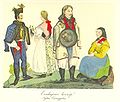Culture of Hungary
This article needs additional citations for verification. (January 2011) |


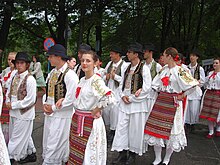
| Part of a series on the |
| Culture of Hungary |
|---|
 |
| People |
| Languages |
|
Mythology |
| Cuisine |
| Festivals |
| Religion |
|
Art |
|
Sport |
Music
Hungarian folk music is a prominent part of the national identity and continues to play a major part in the country’s
Franz Liszt spoke no Hungarian until 1870, when he started to learn the language, but clearly identified himself as Hungarian and founded the Academy of Music. Béla Bartók was also born in the former
Broughton claims that Hungary's "infectious sound has been surprisingly influential on neighbouring countries (thanks perhaps to the common Austro-Hungarian history) and it's not uncommon to hear Hungarian-sounding tunes in Romania, and Slovakia.
Hungarian
During the era of Communist rule in Hungary (1944–1989), a Song Committee examined and censored popular music for traces of subversion and ideological impurity. Since then, however, the Hungarian music industry has begun to recover, producing successful performers in the fields of
Architecture
Hungary is home to:
- Dohány Street Synagogue, the largest synagogue in Europe, and the second largest in the world after the Great Synagogue of Jerusalem in Israel
- Széchenyi Medicinal Bath, the largest medicinal bath in Europe
- Esztergom Basilica, the third-largest church in Europe
- Pannonhalma Archabbey, the second-largest territorial abbey in the world
- Gödöllő, the second-largest Baroque castle in the world
- Pécs, the largest Myles[clarification needed] Necropolis outside Italy
Literature

In earliest times, the Hungarian language was written in a runic-like script (Hungarian: Rovásírás). The country switched to the Latin alphabet after being Christianized under the reign of Stephen I of Hungary (1000–1038). There are no existing documents from before the 11th century.
The oldest written record in Hungarian is a fragment in the Establishing charter of the abbey of Tihany (1055) which, while mostly written in Latin, contains several Hungarian terms, among them the words feheruuaru rea meneh hodu utu rea, "up the military road to Fehérvár". The oldest complete text is the Funeral Sermon and Prayer (Halotti beszéd és könyörgés) (1192–1195), a translation of a Latin sermon. The oldest poem is the Old Hungarian Laments of Mary (Ómagyar Mária-siralom), also a translation from Latin, albeit a flawed one, from the 13th century. It is also the oldest surviving Uralic poem.
Among the first chronicles of Hungarian history were
Renaissance literature flourished under the reign of king Matthias Corvinus (1458–1490). Janus Pannonius—even though he wrote in Latin—is considered one of the most important writers in Hungarian literature; he was also the only significant Hungarian Humanist poet of the period. The first printing house was founded during Matthias' reign by András Hess in Buda. The first book printed in Hungary was the Chronica Hungarorum.
Matthias Corvinus' library, the
The most important poets of the period following the reign of King Matthias were Bálint Balassi (1554–1594) and
The Hungarian enlightenment followed about fifty years after the Western European enlightenment, reaching Hungary through
Hungarian literature has recently gained renown outside the borders of Hungary, mostly through German, French and English translations. Some modern Hungarian authors have become popular in Germany and Italy, especially Sándor Márai, Péter Esterházy, Péter Nádas, and Imre Kertész. Kertész is a contemporary Jewish writer and Holocaust survivor who won the Nobel Prize for literature in 2002.
The classics of Hungarian literature have remained largely unknown outside Hungary. János Arany, a famous 19th-century poet, is still much loved in Hungary, especially his collection of ballads. Arany is among several other "true classics" including Sándor Petőfi, the poet of the Revolution of 1848, Endre Ady, Mihály Babits, Dezső Kosztolányi, Attila József, and János Pilinszky. Other Hungarian authors are Ferenc Móra, Géza Gárdonyi, Zsigmond Móricz, Gyula Illyés, Albert Wass, and Magda Szabó. Vilmos Kondor has created a new trend in recent years, and is mentioned as the creator of Hungarian noir (see Budapest Noir).
Film
Many Hungarians have contributed to film art and its technology, but, due to political reasons, many of them found it was easier to find success abroad. As of 2018, Hungarians working in Hollywood and some in Hungary had received more than 150 Academy Award nominations and about 46 Academy Awards. Already in the 1930s there were 17 Hungarian nominations, but the peak was in the decade of the 1940s when about 51 nominations and 13 to 15 Academy Awards were given to exiled Hungarians. The best year was 1944 with 9 to 10 nominations and four (Michael Curtiz, Paul Lukas, George Pal, and William S. Darling) Academy Awards. The first Hungarian to be nominated was Lajos Bíró (1929) and the first to win the award was William S. Darling (1933). Art Direction might be the most successful category concerning wins/nominations: Paul Groesse 3/11, William S. Darling 3/7, Joseph Kish 1/5, Vincent Korda 1/4, Alexandre Trauner 1/2 and Marcel Vertès 1/1. The number of nominees and awards in all categories, exceeds all other nations, counted per capita.
Hungarians emigrated in large numbers after several disasters following the First World War (1918) when neighbouring countries—Romania, Yugoslavia and Czechoslovakia—occupied parts of the former Kingdom of Hungary, which lost two-thirds of its territory in a 1920 treaty. There was a brief communist takeover accompanied by a so-called ″red terror″ and then a reaction against it called the ″white terror″, which disrupted the economy. At that time Hungarian filmmakers tried their fortunes abroad, first, as did
Nevertheless, despite the hardships of staying at home, some Hungarians received Academy Award nominations (21 times for 24 people up to 2018) and in some cases the actual Award (Ferenc Rofusz (1980), István Szabó (1981), Zsuzsa Böszörményi (1991) and co-winners Jászberényi, Perlaki and Priskin (2010), and co-winners Imre Major and Csaba Kőhegyi in 2014. The first Hungarian to be nominated from Hungary was Tamás Czigány,[8] for best short documentary in 1967.
The best-known Hungarian film to date is
Famous Hungarians in the film industry
Hollywood
Cinematographers
Great Britain
- Alexander Korda founded London films[clarification needed] in order to compete with Hollywood on the same terms. He produced The Third Man with music of Anton Karas.
- Producer Leslie Howard.
Germany
- Géza von Radványi made 70 mm films to compete with Hollywood.
- Josef von Báky (directed Münchausen)
- Géza von Bolváry
- Géza von Cziffra
- Eduard von Borsody
- Julius von Borsody
Israel
Ephraim Kishon (b. Ferenc Hoffmann) was Israel's first nominee for best foreign-language film. He got two nominations (1964, 1972).
Czechoslovakia
Ján Kadár (b. János Kadár) won the first AA for Czechoslovakia (1965).
Canada
Paul Sarossy is active often as Atom Egoyan's cinematographer.
Hungary
Some years after the failed revolution of 1956 against the Soviet-dominated communist dictatorship, the cultural climate eased slightly; this led to more creative freedom. Important films in the 1960s were directed by
Art movies
Hungarians were major pioneers in cinema both in Europe (e.g.
After World War II the greatest Hungarian film director was Miklós Jancsó who won the first two international film prizes:
- The Round-Up (Szegénylegények), FIPRESCI, 1965
- Best Director Award, 1971
- Hungary won Crystal Globe 2016[10][circular reference]
- Hungary won Prix Europa (Best European TV Movie or Mini-series of the Year) 2017: Memo[11]
- Hungary won Prix Europa (Best European TV Movie or Mini-series of the Year) 2018: Eternal Winter by Attila Szász[12]
- Main Prize at Braunschweig Int. Film Festival 2018: X by Ujj Mészáros
- Main Prize at Berlin Int. Film Festival 2018: On Body and Soul by Ildikó Enyedi
- Main Prize at Monte Carlo Int. Film Festival 2019: Bad Poems by Gábor Reisz
- Main Prize at Tuburon Int. Film Festival(US) 2019: Eternal Winter, also: Best Director, Screenplay, Actress and Cinematography
Cuisine
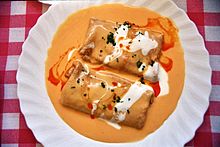
Traditional dishes such as the world-famous
Other dishes include
The csárda is the most distinctive type of Hungarian inn, an old-style tavern offering traditional cuisine and beverages. Borozó usually denotes a cozy old-fashioned wine tavern, pince is a beer or wine cellar, and a söröző is a pub offering draught beer and sometimes meals. The bisztró is an inexpensive restaurant often with self-service. The büfé is the cheapest place, although one may have to eat standing at a counter. Pastries, cake, and coffee are served at a cukrászda, while an eszpresszó is a cafeteria.
Alcoholic beverages
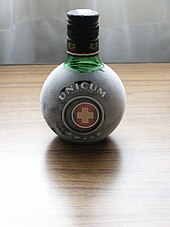
Pálinka: Pálinka is a fruit brandy, distilled from fruit grown in the orchards of the Great Hungarian Plain. It is a spirit native to Hungary, and comes in a variety of flavours including apricot (barack) and cherry (cseresznye). However, plum (szilva) is the most common flavour. Though many flavours are available, pálinka made of strawberries or walnut are considered to be a rare and expensive delicacy; variations also include pálinka sweetened with honey or fruit beds under the liquid.
Zwack
Spa culture
Hungary is a land of
The
The spa culture has a history of nearly 2,000 years in Budapest. Budapest has the richest supply of thermal water among the capitals of the world.[citation needed] There are about 450 public baths in Hungary. Nowadays the trend shows that bath operators are modernizing their facilities and expanding the services offered. A total of 50 of the 160[Inconsistent with the figure of 450] public baths are qualified as spas throughout the country. Services are offered for healing purposes. These spas provide every type of balneal and physical therapy.[14][15]
The wine-growing terroir of Egerszalók
The spa at Egerszalók is noted for its position in one of the principal wine-growing regions of Hungary. Egerszalók is also notable for human-caused geological morphology: when the spa was expanded by the government in 1961, the flow of supersaturated mineral water sharply increased, leading to the deposition of a hillside of shining white travertine.
The thermal lake of Hévíz
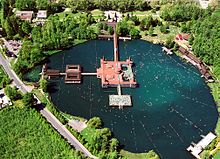
The 4.4 ha (11 acre) lake is fed by its spring rushing up at a depth of 38 m, containing
Folk dance

- weapon dancesbelong in this group.
- Karikázó: a circle dance performed by only women, and accompanied by singing of folksongs.
- Hungarian namefor the national dances, with Hungarian embroidered costumes and energetic music. From the men's intricate bootslapping dances to the ancient women's circle dances, Csárdás demonstrates the infectious exuberance of the Hungarian folk dancing still celebrated in the villages.
- Verbunkos: a solo man's dance evolved from the recruiting performances of the Austro-Hungarian army.
- The Kalotaszeg region of Transylvania. Although usually danced by young men, it can be also danced by older men. The dance is performed freestyle usually by one dancer at a time in front of the band. Women participate in the dance by standing in lines to the side and sing/shout verses while the men dance. Each lad does a number of points (dance phrases) typically 4 to 8 without repetition. Each point consists of 4 parts, each lasting 4 counts. The first part is usually the same for everyone (there are only a few variations).
Embroidery

It was in the beginning of the 18th century that the present style of Hungarian folk art took shape, incorporating both
Nearly all the manifestations of
The finest achievements in their
In Hungary, proper
produce the finest embroideries. In the Sárköz region, the women's caps show black and white designs as delicate as lace and give evidence of the people's wonderfully subtle artistic feeling. The embroidery motifs applied to women's wear have also been transposed to tablecloths and runners suitable for modern use as wall decorations.Folk costumes (17th–19th centuries)
Ceramics
Black pottery
These vessels, made of
Herend Porcelain
Founded in 1826,
Hungarian domestic animals
There are specifically Hungarian breeds of domestic animals which are seen as national symbols in Hungary:
- Long-horn Hungarian Grey Cattle- Hungarian breed, traditionally kept in the open full year. Nowadays, they are raised for infant food due to natural, healthy meat.
- Dogs

A female Vizsla - Carpathian Basinwith the nomadic Hungarian tribes.
- Puli - small shepherd dog
- Magyars.
- Kuvasz - large shepherd dog
- Pumi- small shepherd dog
- Magyar Agár (Hungarian Greyhound) was already known in the 8th century. It is as old as the Vizsla.
- Transylvanian Bloodhound- Hungarian hound
- Mudi - shepherd dog
- Hungarian thoroughbred horses - a mid-19th century mixture of the best Arab and English racehorse characteristics.
- sausages and salami.
Sport
You can help expand this article with text translated from the corresponding article in Hungarian. (April 2010) Click [show] for important translation instructions.
|
Only seven countries (USA, USSR, UK, France, Italy, China, and Germany) have won more Summer Olympic gold medals than
Among the most famous Hungarians is footballer
Hungarians are also known for their prowess at
Despite being landlocked, the presence of two major rivers (the Duna and the Tisza) and a major lake (Balaton), provide excellent opportunities to practice water sports. In recent years there has also been a steady rise in the number of golfers in the country; the sport has developed much over the past 20 years (after the fall of Socialism), but the economic situation hinders further development of golf courses.
Some of the world's best sabre fencing athletes have historically hailed from Hungary.
The
Games
Traditional toys are made from various plants, for example
Ulti is one of the most famous card games played by a 32-card set so-called: "Magyar kártya", exactly: "Tell-Karte" with German decks.
Button football is a tabletop game which is known in Europe, typically in Hungary.
The Rubik's Cube debuted in Hungary in 1977 and gained international fame.
Hungary has produced many top-level
Flag

The flag of Hungary is a horizontal tricolour of red, white and green (red-white-green). This revised style was adopted on the 12th of October 1957 following the Hungarian Revolution of 1956.[23]
The colours of were used during the coronation of Matthias II in 1608. It is speculated that the colours and their relationship with the Hungarian monarchy date back to the 13th century.[24]
The colours of the flag are also present in the traditional Hungarian Coat of Arms. The red is thought to signify the various battles which Hungary has fought in, whilst the white and green denote Hungary's rivers and mountains respectively. [23]
See also
- List of Hungarians
- List of museums in Hungary
- Renaissance architecture in Central Europe
- National symbols of Hungary
References
- ^ "Hungary - Daily life and social customs | Britannica". www.britannica.com. Retrieved 2022-11-14.
- ^ "Hungary's Growing Role in the Balkans". Hungary Today. 2019-07-01. Retrieved 2023-05-10.
- ISBN 978-3-11-220930-1, retrieved 2023-08-24
- ^ Szalipszki, pg.12
Refers to the country as "widely considered" to be a "home of music". - ^ Broughton, pg. 159-167
- ^ Szabolcsi, The Specific Conditions of Hungarian Musical Development
"Every experiment, made from Hungarian antedecents[Not a word. Maybe "antecedents" is intended?] and on Hungarian soil, to create a conscious musical culture (music written by composers, as opposed to folk music), had instinctively or consciously striven to develop widely and universally the musical world of the folk song. Folk poetry and folk music were deeply embedded in the collective Hungarian people’s culture, and this unity did not cease to be effective even when it was given from and expression by individual creative artists, performers and poets." - ^ "BENCE SZABOLCSI: A CONCISE HISTORY OF HUNGARIAN MUSIC". Mek.oszk.hu.
- ^ "Tamás Czigány". IMDb.com.
- ^ "Tibor Madjar". IMDb.
- ^ It's Not the Time of My Life
- ^ "István Tasnádi". IMDb.com. Retrieved 1 January 2019.
- ^ "Örök tél". IMDb.
- ^ "Sulinet: Magyar növény-e a paprika?". Sulinet.hu. Archived from the original on 2008-06-20. Retrieved 2008-11-21.
- ^ "Mini guide to Budapest's spas". BBC. 26 April 2013. Retrieved 25 December 2017.
- ^ Fallon, Steve. "A guide to Budapest's thermal baths". Lonely Planet. Retrieved 25 December 2017.
- JSTOR 207999.
- ^ "Herend". Herend.com.
- ^ Krisztina Egerszegi. Sports-reference.com.
- ^ Krisztina EGERSZEGI. Olympic.org.
- ^ Egerszegi, Krisztina. Encyclopedia.com (2004)
- ^ FINA. 19 August 2013. Archivedfrom the original on 2020-06-21. Retrieved 27 January 2021.
- ^ a b "Dezső Gyarmati". olympedia.org. Olympedia. Archived from the original on 2020-06-03. Retrieved 27 January 2021.
- ^ a b "flag of Hungary | Britannica". www.britannica.com. Retrieved 2022-11-14.
- ^ Kovács, Zsóka (2017-09-02). "No ke aha ke kala o ka hae Hungarian ʻulaʻula-keʻokeʻo-'ōmaʻomaʻo?". Daily News Hungary. Retrieved 2022-11-14.
External links
- Culture of Hungary (Film, Fine arts, Folklore, Literature, Music, Press and Theatre) summarized at the administrative website of Hungary
- Some Hungarian proverbs reflecting the history and culture of the county
- ^ "Copyright: Connections Between Elite Culture and Mass Culture in Hungary". Acta Historica Academiae Scientiarum Hungaricae. 33: 91–92. 1987.













